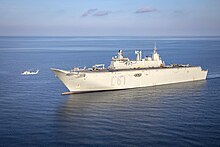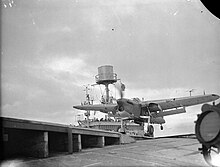
An aircraft carrier is a warship that serves as a seagoing airbase, equipped with a full-length flight deck and facilities for carrying, arming, deploying, and recovering aircraft. Typically, it is the capital ship of a fleet, as it allows a naval force to project air power worldwide without depending on local bases for staging aircraft operations. Carriers have evolved since their inception in the early twentieth century from wooden vessels used to deploy balloons to nuclear-powered warships that carry numerous fighters, strike aircraft, helicopters, and other types of aircraft. While heavier aircraft such as fixed-wing gunships and bombers have been launched from aircraft carriers, these aircraft have not landed on a carrier. By its diplomatic and tactical power, its mobility, its autonomy and the variety of its means, the aircraft carrier is often the centerpiece of modern combat fleets. Tactically or even strategically, it replaced the battleship in the role of flagship of a fleet. One of its great advantages is that, by sailing in international waters, it does not interfere with any territorial sovereignty and thus obviates the need for overflight authorizations from third-party countries, reduces the times and transit distances of aircraft and therefore significantly increases the time of availability on the combat zone.
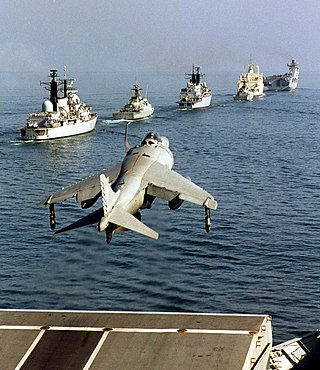
A short take-off and vertical landing aircraft is a fixed-wing aircraft that is able to take off from a short runway and land vertically. The formal NATO definition is:
A Short Take-Off and Vertical Landing aircraft is a fixed-wing aircraft capable of clearing a 15 m obstacle within 450 m of commencing take-off run, and capable of landing vertically.

A vertical take-off and landing (VTOL) aircraft is one that can take off and land vertically without relying on a runway. This classification can include a variety of types of aircraft including helicopters as well as thrust-vectoring fixed-wing aircraft and other hybrid aircraft with powered rotors such as cyclogyros/cyclocopters and gyrodynes.

Takeoff is the phase of flight in which an aerospace vehicle leaves the ground and becomes airborne. For aircraft traveling vertically, this is known as liftoff.

Príncipe de Asturias, originally named Almirante Carrero Blanco, was a light aircraft carrier and former flagship of the Spanish Navy. She was built in Bazán's Shipyards and delivered to the Spanish Navy on 30 May 1988.

A vertical and/or short take-off and landing (V/STOL) aircraft is an airplane able to take-off or land vertically or on short runways. Vertical takeoff and landing (VTOL) aircraft are a subset of V/STOL craft that do not require runways at all. Generally, a V/STOL aircraft needs to be able to hover. Helicopters are not considered under the V/STOL classification as the classification is only used for aeroplanes, aircraft that achieve lift (force) in forward flight by planing the air, thereby achieving speed and fuel efficiency that is typically greater than the capability of helicopters.

Giuseppe Garibaldi is an Italian aircraft carrier, the first through-deck aviation ship ever built for the Italian Navy, and the first Italian ship built to operate fixed-wing aircraft. Although she is widely recognised as a carrier first and foremost, she is officially designated as an aircraft-carrying cruiser. She is equipped with short take-off and vertical landing (STOVL) aircraft and helicopters. Giuseppe Garibaldi was involved in combat air operations off Somalia, Kosovo, Afghanistan and Libya.
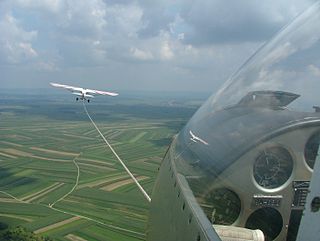
In aviation, assisted takeoff is any system for helping aircraft to get into the air. The reason it might be needed is due to the aircraft's weight exceeding the normal maximum takeoff weight, insufficient power, insufficient available runway length, or a combination of all three factors. Assisted takeoff is also required for gliders, which do not have an engine and are unable to take off by themselves.

The flight deck of an aircraft carrier is the surface from which its aircraft take off and land, essentially a miniature airfield at sea. On smaller naval ships which do not have aviation as a primary mission, the landing area for helicopters and other VTOL aircraft is also referred to as the flight deck. The official U.S. Navy term for these vessels is "air-capable ships".

The Centaur class aircraft carrier was the final iteration of the 1942 Design Light Fleet Carrier developed by the United Kingdom for the Royal Navy during the Second World War. They were designed in 1943 to operate higher-performance aircraft than the preceding Majestic-class aircraft carrier. Four ships were laid down in 1944-1945 and completed in 1953-1959. Rapid developments in carrier warfare and technology overtook the ships even as they were under construction, and the associated costs of modernization led to ships being completed to different specifications. Only the last ship, HMS Hermes (R12), was fitted as a modern fixed-wing carrier; she was also the last of the class to retire in 2017 as INS Viraat.

STOBAR is a system used for the launch and recovery of aircraft from the deck of an aircraft carrier, combining elements of "short take-off and vertical landing" (STOVL) with "catapult-assisted take-off, barrier-arrested recovery" (CATOBAR).

Naval aviation is the application of military air power by navies, whether from warships that embark aircraft, or land bases.

An aircraft catapult is a device used to allow aircraft to take off in a limited distance, typically from the deck of a vessel. They can also be installed on land-based runways, although this is rarely done. They are usually used on aircraft carriers as a form of assisted take off.

Dédalo was the first Spanish aircraft carrier and the second aviation ship in the Spanish Navy. She remained the fleet's flagship until Príncipe de Asturias replaced her. Dédalo was formerly the World War II-era light aircraft carrier USS Cabot, which was acquired from the United States in the 1960s.

Juan Carlos I is a multi-purpose amphibious assault ship-aircraft carrier in the Spanish Navy. Similar in role to many aircraft carriers, the amphibious landing ship has a ski jump for STOVL operations, and is equipped with the McDonnell Douglas AV-8B Harrier II attack aircraft. The vessel is named in honour of Juan Carlos I, the former King of Spain.

The aircraft cruiser is a warship that combines the features of the aircraft carrier and a surface warship such as a cruiser or battleship.
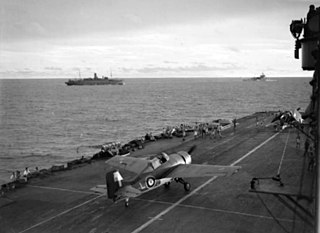
Aircraft carriers are warships that evolved from balloon-carrying wooden vessels into nuclear-powered vessels carrying many dozens of fixed- and rotary-wing aircraft. Since their introduction they have allowed naval forces to project air power great distances without having to depend on local bases for staging aircraft operations.

A carrier-based aircraft is a naval aircraft designed for operations from aircraft carriers. Carrier-based aircraft must be able to launch in a short distance and be sturdy enough to withstand the abrupt forces of launching from and recovering on a pitching deck. In addition, their wings are generally able to fold up, easing operations in tight quarters.
Aircraft can have different ways to take off and land. Conventional airplanes accelerate along the ground until sufficient lift is generated for takeoff, and reverse the process to land. Some airplanes can take off at low speed, this being a short takeoff. Some aircraft such as helicopters and Harrier jump jets can take off and land vertically. Rockets also usually take off vertically, but some designs can land horizontally.
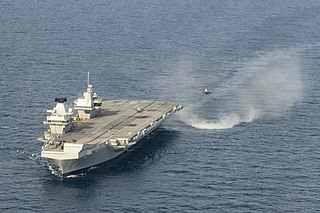
Shipborne rolling vertical landing (SRVL) is a method used to land a V/STOL aircraft that uses both the vertical thrust from the jet engine and lift from the wings.

